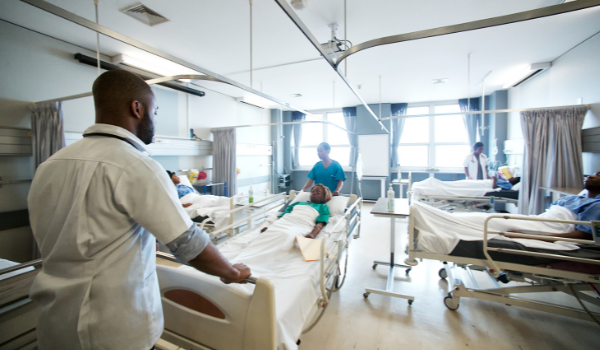Second Opinion Programs: What About Physician Burnout?

Dr. William Osler said that “the practice of medicine is an art, not a trade; a calling,
not a business; a calling in which your heart will be exercised equally with your head."
Unfortunately for the American physician that heart hangs heavy, for even before COVID ravaged the U.S. hospital system, America’s doctors were already battling a pandemic. Though unlike the plagues of the past, this disease affected not patients: but doctors.
Physicians have often borne the brunt of America’s ever-changing healthcare landscape. And the adjustments they’ve made — specifically in how care is provided, documented, and reimbursed — have stretched resources and exposed technologies that hinder rather than enhance patient care. All of these factors have contributed to an epidemic of burnout among healthcare workers.
Burnout is a workplace syndrome caused by physical and psychological stressors and is characterized by emotional exhaustion, depersonalization (i.e. cynicism), and a diminished sense of personal accomplishment. What is alarming — albeit, not surprising — is that regardless of clinical discipline or setting, burnout affects every employee involved in healthcare delivery.
As such, COVID is a pandemic thrust upon an ongoing pandemic: a pandemic of burnout.
Burnout affects physicians through all phases of their career with the incidence of burnout among medical students and residents is between 40% and 76%., 1,2 Though prevalence rates vary between studies, it’s thought that burnout affects around half of physicians in the U.S. which is significantly higher than burnout rates seen among U.S.3 workers in other fields. Interesting, having a professional degree reduces the risk of burnout in other fields while increasing the risk for those within medicine.4
Burnout can have significant repercussions for physicians and has been linked to substance abuse5, interpersonal conflicts6, poor professionalism7, and suicidal ideation.8 Aside from the detrimental impact on the well-being of physicians, burnout is associated with decreased patient satisfaction, increased medical errors, poorer health outcomes, and higher health care cost.9,10,11 It is estimated that the annual cost of physician turnover secondary to burnout is between $2.6 to $6.3 billion.12
The literature suggests that burnout is a systematic problem that seeps into the very core of the U.S. medical system. Though its cause is likely due to the way healthcare is delivered rather than in the personal characteristics of those who deliver it.
EHR related clerical burden distracts from patient care and contributes to burnout
Over the past decade, the rapid adoption of electronic health records (EHR) — facilitated by the passage of the Health Information Technology for Economic and Clinical Health Act — has dramatically altered the workday for the American physician. Though EHRs have shown promise in improving patient mortality13, health care quality14 and communication15, they have had the unintended consequence of magnifying the very problem they were designed to mitigate: clerical burden.16
A study by Sinsky et al. found that for every hour physicians spend delivering face time care to patients, nearly two additional hours are spent facing a computer or doing paperwork.17 In a study comparing the notes of U.S. physicians to those of physicians outside the states, it was found that the notes of U.S. physicians were four times longer than their overseas counterparts.18 The average U.S clinician spends as much time using the EHR as a non-U.S. clinician in the 99th percentile of EHR usage.19
None of this increased burden in benign, with studies demonstrating an association between EHR usage and clinician burnout.20
EHR systems were intended to usher in a new era of patient safety, record accessibility, and increased efficiency. Instead, they have dramatically altered the nature of physicians’ work by increasing clerical burden, interfering with physician-patient interactions, and distracting from meaningful aspects of clinical practice.21
Today, most of the emphasis on burnout prevention focuses on boosting resilience through mindfulness training, and although individual resilience is important, more attention must be paid to how medicine is practiced in the era of EHRs.
The ideal strategy to prevent burnout would have two aims: increasing a physician’s capacity to handle stress and reducing stressful stimuli (i.e. clerical burden).
An Asynchronous Solution
Asynchronous programs, such as remote second opinions (also referred to as online or virtual second opinions), have been shown to deliver on the promise of EHRs by reducing administrative burden. These programs empower patients to take charge of their care, often with patients uploading records on their own.
Software (such as Purview's Expert View) collects and centralizes a patient’s pertinent medical information into a secure cloud platform. This information is then aggregated and distilled by a case management team for presentation. In this way, physicians have the opportunity to render a clinical opinion in the absence of bureaucratic burden.
The expert physician receives a succinct case summary together with the supporting documentation necessary to render an opinion. Purview’s staff ensures that consultants start with the most relevant data first, with the option to dig deeper depending on the case’s complexity.
All of this means that doctors can do what they were trained to do without the bureaucratic hurdles of ICD codes, prior authorizations, and mountains of digital paperwork. Since the consults are asynchronous, doctors can review the materials from any secure computer and answer a patient’s specific questions at a time that suits their schedule.
Remote second opinion programs offer a return to old school medicine via a modern healthcare delivery interface. Not only does this have the potential to restore what Osler called the, “calling in which your heart will be exercised equally with your head,” but it gives patients access to expert medical opinions outside their geographical area.
Though remote second opinion programs are not a solution to burnout, they provide an outlet for physicians to do what they trained to do: help the most people in the most profound ways. Hospitals like The Cleveland Clinic and Memorial Sloan Kettering recently discussed how they have successfully launched remote second opinion programs by collaborating with their physicians to ensure that these new systems were integrated seamlessly the current workflow and actively enhanced patient care.
Both institutions started out with voluntary participation because they recognized that remote second opinions wouldn’t appeal to every physician. For those physicians who decided to participate, both hospitals offered incentives including moonlighting rates for each consult. Additionally, remote second opinion consults were built into the physician’s daily workflow rather than heaped atop an already busy schedule. Cases were screened beforehand so that physicians were only fielding consults that specifically matched their subspecialty or niche expertise.
Epstein and Privitera22 wrote in an editorial for The Lancet that, “physicians, disillusioned by the productivity orientation of administrators and absence of affirmation for the values and relationships that sustain their sense of purpose, need enlightened leaders who recognize that medicine is a human endeavor and not an assembly line.”
Remote second opinion programs can be part of a solution that addresses the systemic and institutional forces that contribute to burnout. Any effort — be it big or small — that promotes well being and restores the integrity of America’s physicians is well worth it.
The goal of remote second opinion programs is to create a system of care delivery where there is no limit to the challenges faced by doctors and patients alike, nor bounds on the solutions that doctors and patients can discover together.
Register for a demonstration of Expert View:
The remote second opinion technology platform.
1 Dyrbye LN, Thomas MR, Massie FS, Power DV, Eacker A, Harper W, Durning S, Moutier C, Szydlo DW, Novotny PJ, Sloan JA, Shanafelt TD. Burnout and suicidal ideation among U.S. medical students. Ann Intern Med. 2008 Sep 2;149(5):334-41. doi: 10.7326/0003-4819-149-5-200809020-00008. PMID: 18765703.
2 Williams D, Tricomi G, Gupta J, Janise A. Efficacy of burnout interventions in the medical education pipeline. Acad Psychiatry. 2015;39(1):47-54. doi:10.1007/s40596-014-0197-5
3 Shanafelt TD, Hasan O, Dyrbye LN, et al. Changes in Burnout and Satisfaction With Work-Life Balance in Physicians and the General US Working Population Between 2011 and 2014 [published correction appears in Mayo Clin Proc. 2016 Feb;91(2):276]. Mayo Clin Proc. 2015;90(12):1600-1613. doi:10.1016/j.mayocp.2015.08.023
4 Shanafelt TD, Boone S, Tan L, et al. Burnout and satisfaction with work-life balance among US physicians relative to the general US population. Arch Intern Med. 2012;172(18):1377-1385. doi:10.1001/archinternmed.2012.3199
5 Oreskovich MR, Kaups KL, Balch CM, et al. Prevalence of alcohol use disorders among American surgeons. Arch Surg. 2012;147(2):168-174. doi:10.1001/archsurg.2011.1481
6 Warde CM, Moonesinghe K, Allen W, Gelberg L. Marital and parental satisfaction of married physicians with children. J Gen Intern Med. 1999;14(3):157-165. doi:10.1046/j.1525-1497.1999.00307.
7 Dyrbye LN, Massie FS Jr, Eacker A, Harper W, Power D, Durning SJ, Thomas MR, Moutier C, Satele D, Sloan J, Shanafelt TD. Relationship between burnout and professional conduct and attitudes among US medical students. JAMA. 2010 Sep 15;304(11):1173-80. doi: 10.1001/jama.2010.1318. PMID: 20841530.
8 Shanafelt TD, Balch CM, Dyrbye L, et al. Special report: suicidal ideation among American surgeons. Arch Surg. 2011;146(1):54-62. doi:10.1001/archsurg.2010.292
9 Rabatin J, Williams E, Baier Manwell L, Schwartz MD, Brown RL, Linzer M. Predictors and Outcomes of Burnout in Primary Care Physicians. J Prim Care Community Health. 2016;7(1):41-43. doi:10.1177/2150131915607799
10 Halbesleben JR, Rathert C. Linking physician burnout and patient outcomes: exploring the dyadic relationship between physicians and patients. Health Care Manage Rev. 2008;33(1): 29-39.
11 DeVoe J, Fryer Jr GE, Hargraves JL, Phillips RL, Green LA. Does career dissatisfaction affect the ability of family physicians to deliver high-quality patient care?. J Fam Pract. 2002;51(3):223-228.
12 Han S, Shanafelt TD, Sinsky CA, et al. Estimating the Attributable Cost of Physician Burnout in the United States. Ann Intern Med. 2019;170(11):784-790. doi:10.7326/M18-1422
13 Holmgren AJ, Pfeifer E, Manojlovich M, Adler-Milstein J. A Novel Survey to Examine the Relationship between Health IT Adoption and Nurse-Physician Communication. Appl Clin Inform. 2016;7(4):1182-1201. Published 2016 Dec 21. doi:10.4338/ACI-2016-08-RA-0145
14 Lin SC, Jha AK, Adler-Milstein J. Electronic Health Records Associated With Lower Hospital Mortality After Systems Have Time To Mature. Health Aff (Millwood). 2018;37(7):1128-1135. doi:10.1377/hlthaff.2017.1658
15 Holmgren AJ, Patel V, Adler-Milstein J. Progress In Interoperability: Measuring US Hospitals' Engagement In Sharing Patient Data. Health Aff (Millwood). 2017;36(10):1820-1827. doi:10.1377/hlthaff.2017.0546\
16 Tseng P, Kaplan RS, Richman BD, Shah MA, Schulman KA. Administrative Costs Associated With Physician Billing and Insurance-Related Activities at an Academic Health Care System. JAMA. 2018;319(7):691-697. doi:10.1001/jama.2017.19148
17 Sinsky C, Colligan L, Li L, et al. Allocation of Physician Time in Ambulatory Practice: A Time and Motion Study in 4 Specialties. Ann Intern Med. 2016;165(11):753-760. doi:10.7326/M16-0961
18 Downing NL, Bates DW, Longhurst CA. Physician Burnout in the Electronic Health Record Era: Are We Ignoring the Real Cause?. Ann Intern Med. 2018;169(1):50-51. doi:10.7326/M18-0139
19 Holmgren AJ, Downing NL, Bates DW, et al. Assessment of Electronic Health Record Use Between US and Non-US Health Systems [published correction appears in JAMA Intern Med. 2021 Feb 1;181(2):296]. JAMA Intern Med. 2021;181(2):251-259. doi:10.1001/jamainternmed.2020.7071
20 Gardner RL, Cooper E, Haskell J, et al. Physician stress and burnout: the impact of health information technology. J Am Med Inform Assoc. 2019;26(2):106-114. doi:10.1093/jamia/ocy145
21 Toll E. A piece of my mind: the cost of technology. JAMA. 2012; 307(23):2497-2498.
22 Epstein RM, Privitera MR. Doing something about physician burnout. Lancet. 2016;388(10057):2216-2217. doi:10.1016/S0140-6736(16)31332-0



